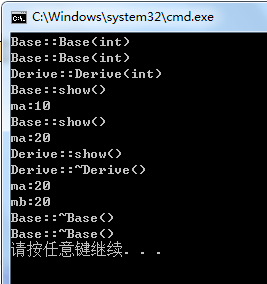动多态发生的情况:指针或者引用的完整对象调用虚函数
pb1->show();
pb2->show();
pd1->show();
分析以上产生静多态还是动多态?
#include<iostream>
using namespace std;
class Base
{
public:
Base(int a) :ma(a)
{
cout << "Base::Base(int)" << endl;
}
~Base()
{
cout << "Base::~Base()" << endl;
}
virtual void show()
{
cout << "Base::show()" << endl;
cout << "ma:" << ma << endl;
}
protected:
int ma;
};
class Derive :public Base
{
public:
Derive(int b) :mb(b), Base(b)
{
cout << "Derive::Derive(int)" << endl;
}
~Derive()
{
cout << "Derive::~Derive()" << endl;
cout << "ma:" << ma << endl;
cout << "mb:" << mb << endl;
}
void show()
{
cout << "Derive::show()" << endl;
}
private:
int mb;
};
int main()
{
Base b(10);
Derive d(20);
Base* pb1 = &b;
pb1->show();
Base* pb2 = &d;
pb2->show();
Derive* pd1 = &d;
pd1->show();
}
基类和派生类中均无虚函数,则均为静多态

基类中无虚函数,派生类中有虚函数:分别为静多态、静多态(从指针所对应的基类Base中找show,看是不是虚函数,不满足,则为静多态)、动多态

基类中有虚函数,派生类中也有虚函数(从基类中继承过来的):三个调均产生动多态

Base& rb1 = b;
rb1.show();
Base& rb2 = d;
rb2.show();
Derive& rd1 = d;
rd1.show();以上引用和前边指针同理。